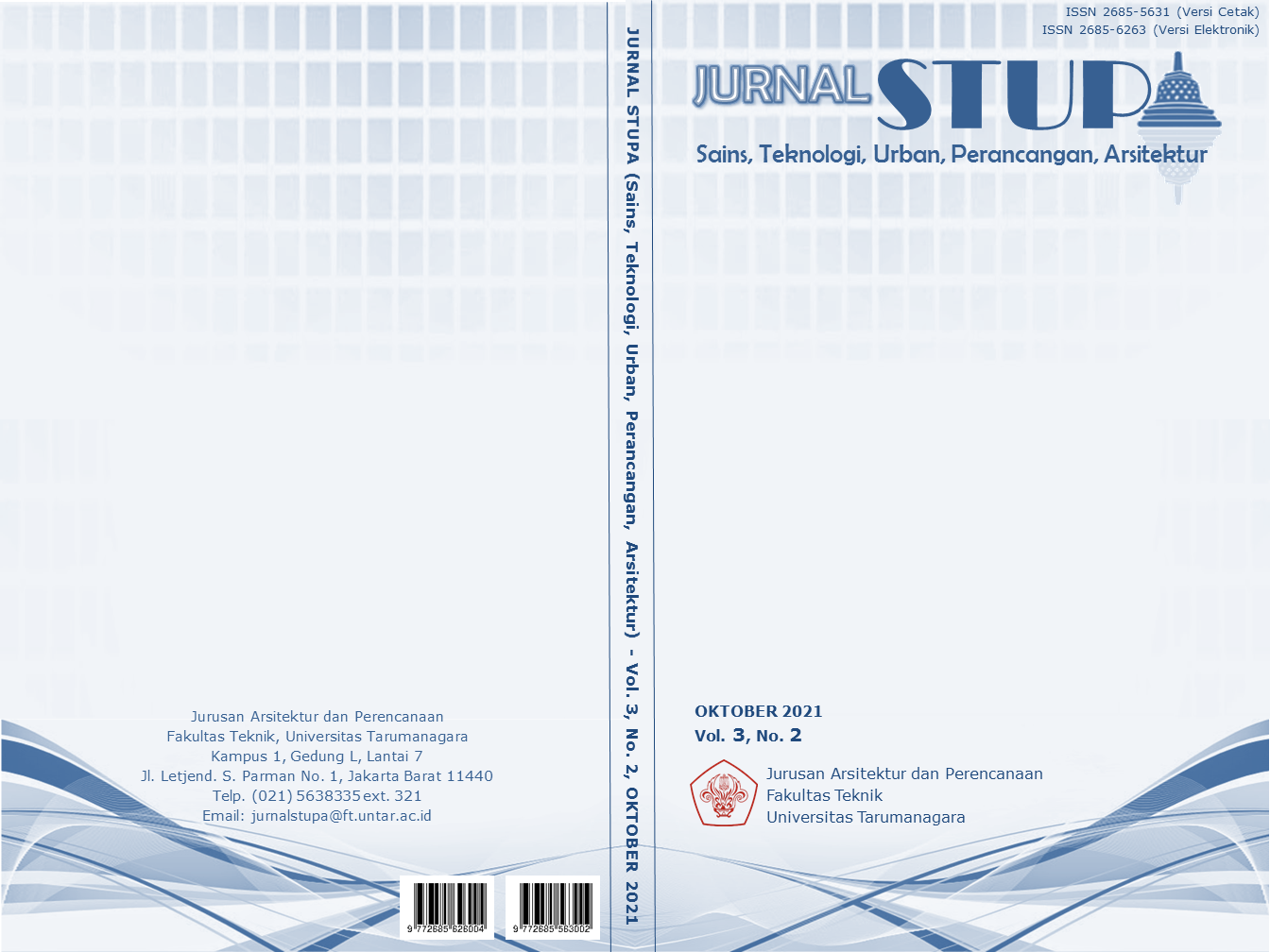NORMAL LIVING: ARSITEKTUR BERPERAN SEBAGAI PENGUBAH STIGMA BURUK & DISKRIMINASI ATAS KAUM DIFABEL
Main Article Content
Abstract
Built based on the keep-increasing issues of disabilities for those who live in the event of poverty due to discriminations, or for not having the same rights and/or opportunities as others on the community. Though, also reflected from the point of view of architectural that most of the spaces contain physical barriers, which Un purposely happened to create “design apartheid”, where disabilities treated as ones who are ‘excluded’ in the area caused by the inaccessible layout in the space. Normal Living is a project, built and located in Sunter Agung, where disabilities, specifically who are in wheelchairs, are given the opportunities of working in industry such as kebayas, dresses, and suits,. The product’s later will be shown and presented through Wheelchair Dance and Fashion Runway. In daily life they are also given a quite decent life support, such as, a proper living accommodation with the existence of urban farming activities to provide their daily need of food. For moral support, they could do their social-life in the provided community. Normal Living is built with purpose to remove bad stigma of the inabilities of disabilities, which been overly years becoming what the public belief. Not only to remove it from public, but more importantly to remove it from the disabilities themselves. In order to reach it, Normal Living is up to create self confident in each of the disabilities. Therefore we can actually agree that between normal and abnormal are only about perceptions. Normal Living is an architectural projects that implied with Equality campaign, doing such activities (which were used to be considered as the inabilities of disabilities) through entertainment, dancing and fashion. In order to reach the described- above purpose, firstly Normal Living uses the planning method to put the comforts of disabilities as its primer priority and spatial perception to build perception for building users. The second one is to create collective programs, followed by the third which is to emphasize the transparency aspects during the material of proof.
Keywords: Disabilities; Decent Living Places; Spatial Perception
Berlatar belakangi isu Difabel yang kian berujung menjadi pengangguran lalu hidup miskin karena terjadinya diskriminasi terhadap mereka, atau tidak mendapatnya hak dan kesempatan yang sama seperti kalangan masyarakat lainnya. Yang bahkan bisa dilihat dari sisi arsitektur pun, sebagian besar sebuah ruang berisi penghalang fisik yang secara tidak sengaja menciptakan “desain apartheid”, di mana penyandang disabilitas dikecualikan dari area karena tata letak ruang yang tidak dapat diakses. Normal Living merupakan sebuah proyek berlokasi di Sunter Agung dimana para Tuna Daksa berkusi roda diberi pekerjaan pada industri kebaya, gaun dan jas, yang nanti nya akan mereka pamerkan melalui wheelchair dance & fashion runway. Mereka diberi penghidupan layak yaitu diberi akomodasi tempat tinggal dengan adanya Farming sebagai Suplai Makanan mereka, dan tentu sebagai tempat mereka mendapatkan moral support lewat hidup berkomunitas. Normal Living ini bertujuan untuk mengubah stigma buruk yang beredar di masyarakat kalau mereka tidak bisa melakukan apa-apa, mengubah dari internal diri mereka sendiri untuk membuat mereka merasa percaya diri bahwa mereka normal, karena bahwasanya, pelabelan normal dan tidak normal hanyalah sebuah persepsi. Sehingga secara implisit, Normal Living bertujuan sebagai produk arsitektural yang berkampanye akan kesetaraan. Melakukan aktivitas yang dianggap mereka tidak bisa lakukan lewat entertainment - menari dan menjadi fashionable. Untuk mencapai tujuan dari proyek ini Metode Perancangan yang digunakan pada Normal Living ini yang pertama yaitu Kenyamanan Mereka Para pengguna kursi roda adalah prioritas Utama, lalu persepsi spasial untuk membentuk persepsi kepada para pengguna bangunan, yang kedua berbentuk program kolektif dan ketiga, menegaskan aspek transpansi pada material untuk pembuktian.
Article Details
References
Boys, J. (2014). Doing Disability Differently. New York: Routledge.
Chernichenko, A. (n.d.). UNIVERSAL DESIGN IN URBAN ENVIRONMENT. Retrieved from Future Architecture: https://futurearchitectureplatform.org/projects/eaafe2fe-ec16-40c1-84ce- 914ca006b64e/
Commission for Architecture and the Built Environment. (2008). Inclusion by design.
Disability and Poverty. (2021, April 23). Retrieved from Wikipedia The Free Encyclopedia: https://en.wikipedia.org/wiki/Disability_and_poverty
Fajri Nursyamsi, E. D. (n.d.). Kerangka Hukum Disabilitas di Indonesia : MENUJU INDONESIA RAMAH DISABILITAS.
Hapsari, G. (2011). Aksesibilitas Difabel dalam Ruang Publik (Studi Deskriptif Kualitatif Mengenai Aksesibilas Difabel Dalam Ruang Publik di Kota Surakarta).
Institute of Medicine of National Academies. (2007). The Future of Disability in America. Washington, D.C.: The National Academies Press .
KEPUTUSAN MENTERI PEKERJAAN UMUM REPUBLIK INDONESIA. (1998). PERSYARATAN TEKNIS AKSESIBILITAS PADA BANGUNAN UMUM DAN LINGKUNGAN. DEPARTEMEN PEKERJAAN UMUM.
Kustiani, R. (2020, September 11). 10 Sebab Pengangguran pada Penyandang Disabilitas Terbilang Tinggi. Retrieved from TEMPO.CO: https://difabel.tempo.co/read/1385107/10-sebab- pengangguran-pada-penyandang-disabilitas-terbilang-tinggi
Rof'ah. (2014). Mengurangi Kompleksitas Kemiskinan Difabel. 245.
Zumthor, P. (2006). Atmospheres: Architectural Environments, Surrounding Objects.


